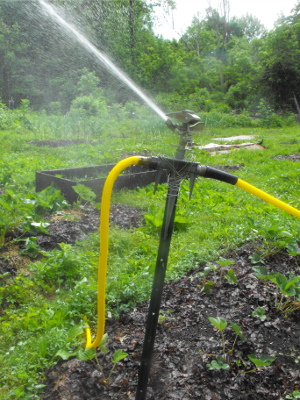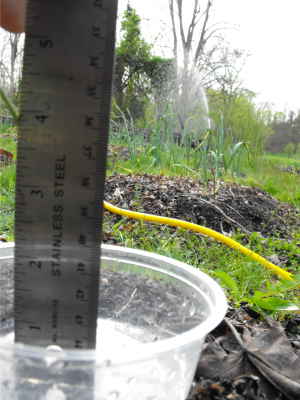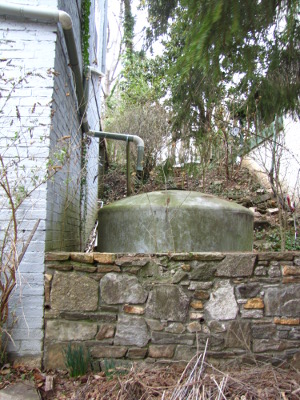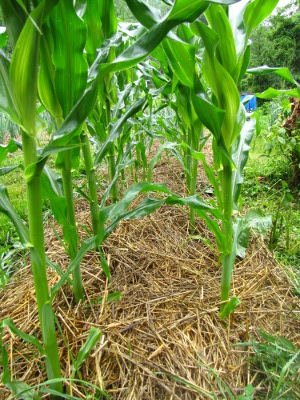
Pros and cons of watering your garden
 Many
gardeners don't water their garden at all, or just spot-water with a
cup or hose during transplanting or when specific plants wilt.
However, water is one of the most common limiting
factors, even in a
very wet climate like ours. Long before your plants droop,
they'll slow their growth to conserve moisture, so your yields in an
unwatered garden will be much lower.
Many
gardeners don't water their garden at all, or just spot-water with a
cup or hose during transplanting or when specific plants wilt.
However, water is one of the most common limiting
factors, even in a
very wet climate like ours. Long before your plants droop,
they'll slow their growth to conserve moisture, so your yields in an
unwatered garden will be much lower.
The importance of
regular irrigation was brought home to me this year when I got sick and
skipped watering for one hot week right when our earliest bed of Sugar
Baby watermelons was bulking up. Those fruits clocked in around
five inches in diameter, compared to the fruits on a later bed of the
same variety (well watered throughout their life) that produced ten
inch fruits. The moral of the story is --- your yields may double
if you provide a steady supply of water for your crops.
 Of
course, watering your garden has many disadvantages. When you
look at the bigger picture, using more than your fair share of rivers
can cause them to dry up downstream, and there's nearly always at least
some energy required to move water to your crops. Closer to home,
irrigation equipment costs money, and so does either paying for city
water or paying the operating costs of your own pumps. I estimate
that we use a phenomenal 11,000 gallons of water every week during the
height of summer (exempting wet periods) to keep our vegetables
growing, which adds about $125 per year to our annual electric bill.
Of
course, watering your garden has many disadvantages. When you
look at the bigger picture, using more than your fair share of rivers
can cause them to dry up downstream, and there's nearly always at least
some energy required to move water to your crops. Closer to home,
irrigation equipment costs money, and so does either paying for city
water or paying the operating costs of your own pumps. I estimate
that we use a phenomenal 11,000 gallons of water every week during the
height of summer (exempting wet periods) to keep our vegetables
growing, which adds about $125 per year to our annual electric bill.
At the plant level, watering
can even do harm.
Overwatering hurts plants, and so does irregular watering. If
your crops are used to getting a regular dose of water every time the
soil starts to dry out, they won't have grown the deep roots needed to
withstand a drought (or to survive a week when you forget to water),
and wet leaves promote fungal diseases (like my tomato blights.)
If you water too much, you can also wash nutrients out of the soil,
which can stunt your plants and make your homegrown food less tasty and
nutritious. The trick here is to know your system and water
scientifically.
 Unless
your climate is very arid (in which case it may not be sustainable to
live there in the first place), you can work around the other
irrigation-related problems as well. Catching rainwater is
something we want to get more serious about --- if you live in a large,
modern home and just have a small backyard garden, chances are your
roof runoff may be all you need to keep your plants hydrated. We
live in a small, unmodern trailer, but we're pondering adding gutters
to the East Wing, the barn, and/or the dreamed-of summer kitchen.
Unless
your climate is very arid (in which case it may not be sustainable to
live there in the first place), you can work around the other
irrigation-related problems as well. Catching rainwater is
something we want to get more serious about --- if you live in a large,
modern home and just have a small backyard garden, chances are your
roof runoff may be all you need to keep your plants hydrated. We
live in a small, unmodern trailer, but we're pondering adding gutters
to the East Wing, the barn, and/or the dreamed-of summer kitchen.
The next step to
watering in a sustainable manner is to make the water you do have go
further. Our watering method is the least efficient one out there
--- sprinklers --- which we chose for the
reasons listed here.
Using sprinklers means that we consume four times as much water as
necessary every time we irrigate --- some of that extra water hits the
garden aisles, some falls outside the garden perimeter, and some
evaporates into the hot summer air. Drip irrigation is the
typical solution to this problem, but it's far from my favorite since
turbid water messes up the system in short order, you have to use lots
of expensive, plastic hoses and replace them often, and drip irrigation
works much better with row crops than with beds. Pitcher
irrigation is a more
permanent solution, but one that only works on a very small scale and
is labor-intensive. I'm still pondering a more efficient watering
option appropriate to our vegetable garden layout.
 Meanwhile, there's always
mulch! Mulching around your plants cools the soil surface and
keeps water from evaporating away, so there's more water available for
your plants and you don't have to irrigate as often. Adding
organic matter to your soil with cover crops and compost will also make
watering less essential every year since this black gold acts like a
sponge, grabbing excess water during heavy rains and then releasing it
to plant roots on demand.
Meanwhile, there's always
mulch! Mulching around your plants cools the soil surface and
keeps water from evaporating away, so there's more water available for
your plants and you don't have to irrigate as often. Adding
organic matter to your soil with cover crops and compost will also make
watering less essential every year since this black gold acts like a
sponge, grabbing excess water during heavy rains and then releasing it
to plant roots on demand.
What watering system do
you use in your garden? Why did you choose it and what do you
love and hate about it? I'm especially curious to hear from
large-scale, no-till gardeners, of course, but everyone should feel
free to chime in!
Want more in-depth information? Browse through our books.
Or explore more posts by date or by subject.
About us: Anna Hess and Mark Hamilton spent over a decade living self-sufficiently in the mountains of Virginia before moving north to start over from scratch in the foothills of Ohio. They've experimented with permaculture, no-till gardening, trailersteading, home-based microbusinesses and much more, writing about their adventures in both blogs and books.
Want to be notified when new comments are posted on this page? Click on the RSS button after you add a comment to subscribe to the comment feed, or simply check the box beside "email replies to me" while writing your comment.

I don't garden on a large scale anymore, so I mulch heavy and water by hand.
In the past I had large gardens and very sandy soil, so watering was always an issue. I had a setup similar to yours. I had a pump drawing water from the creek. At that time I used overhead sprinklers.
I had always considered making my own drip/seep or close to the ground spray irrigation system from pvc pipe or old garden hoses.
I thought about punching or drilling small holes in an old garden hose. My thought was that the holes would be larger and small particle from the creek water might not plug is up. I had considered using the same idea but using pvc pipe instead. It could be hung a few inches above the ground to prevent dirt and sand from plugging the holes, but my thought was I would have less water wasted in the wind and due to evaporation.
I never did experiment with any of these ideas so just remember, this in only a theory, unless it works.
But I strongly encourage Mark To experiment with this, because then I don't have to...lol
Mark actually built some homemade driplines very much like the ones you mention --- PVC pipes with relatively big holes. The holes only rarely clogged, which made them work quite well, but we never got them going again the second year after freezes burst the fittings apart. (I'm sure we could have --- just didn't have time and it was wet enough that the berries didn't suffer.)
They worked well for the linear rows of permanent plantings that we used them for, but would have been more difficult in a broadcast-seeded bed setting where plants are varying distances apart. Since our garden isn't arranged in rows, I think they'd be more trouble than they're worth there.
I got an idea when I was reading your comment Justin.
Some sort of mini sprinkler, maybe have one for each bed and make it shoot a gentle flow of water towards the plants.
Of course this would be a lot of work to set up, and it would need to be taken down for the winter.
Something I might consider if we didn't have such an abundant creek to draw upon. Makes me think of the Field Lab guy in Texas who is building a greenhouse in the desert and blogging about it on Blogspot.
Have you calculated how much rainfall you can collect? In my permaculture course we used a fairly simple method to calculate an estimate of annual rainwater availability.
1 cubic foot of water is about 7.48gal. Calculate the sq foot of all of your hard surfaces (those that can harvest water), multiply it by the number of feet of rainfall that you get in a year. We get 62" (5.16 ft) per year, and have a 900 sq ft roof.
5.16ft900sqft= 4644 cu ft. 7.48 gal/cuft= 34,000+ gallons of rainwater coming off our roof.
We need to get started harvesting all of this. I definitely agree with watering. It's rainy down here but it seems like very little of that rain falls in the summer, or it all falls in big bursts with several dry weeks in between. I don't have a good watering system and I have yet to get a really superb harvest because of it. As soon as it gets hot, everything wilts except the figs, even with mulch.
That's how I got the figures in my Barn Roof post about getting 48,000 gallons per year from the barn. Thanks for posting the formula --- I'm sure that will help others out!
It's funny how you can have flood one week and the next week the plants wilt! They really do like a steady supply.
I'm in central Texas and we're experiencing a severe drought, and because of that I don't want to use sprinklers. I'd like drip but we have hard water and it clogs very easily--you can treat water before it goes into a drip system so it removes unwanted stuff, but I haven't had the time to look into it or the money to invest in it.
I made some ollas this year but only managed to bury one, and the few plants around it got dug up by armadillos and I never replanted. It was working well while there were plants there. I refilled it about once every three days (about 3-4 gallons). Drawback was you have to have a lot of them, because their spacing is only about 3 feet max. That's a lot of terra cotta and a lot of holes to dig.
What I use on everything else is soaker hoses covered with mulch. I have both cheap and expensive ones and can't tell the difference so far, although the more expensive ones feel more solid like they will hold up longer. Drawback is I can't always tell if the hose has shifted until a plant starts wilting. Even then it's hard to get it to line up without pulling it off another plant.
Mark, Little mini sprinklers is exactly what I was thinking of.
One other idea. I never used it on my sprinkler system, but I did have a water filter I used if I was running creek water through my preassure washer. It had a plastic case with a screw on base and replaceable filter cartridges. I just used some filters that were rated for sand and iron I think. It was not expensive. I bet you could use that filter with commercial drip irrigation tube and not have much trouble with it plugging up.
Just a thought.
Chris --- Drought is definitely a good reason not to waste water. I'm glad you posted about your experience with pitcher irrigation --- I've actually never tried it, so it's good to hear that your experiment matched up with my gut feelings.
Justin --- We actually have had good luck with the little yellow sprinklers you can see here, labeled "stationary sprinklers." They really don't clog and only water a small area, which would be perfect if we put in the infrastructure to have one in each garden bed.